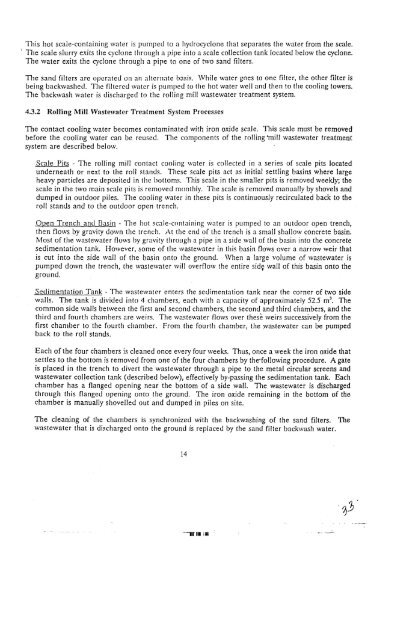Watcr Q!!alit\1 lmprovcmct1t at1() COf1scrvatiof1l'rojcct
Watcr Q!!alit\1 lmprovcmct1t at1() COf1scrvatiof1l'rojcct
Watcr Q!!alit\1 lmprovcmct1t at1() COf1scrvatiof1l'rojcct
You also want an ePaper? Increase the reach of your titles
YUMPU automatically turns print PDFs into web optimized ePapers that Google loves.
This hot scale-containing water is pumped to a hydrocyclone that separates the water from the scale.<br />
: TIle scale slurry exits the cyclone through a pipe into a scale collection tank located below the cyclone.<br />
The water exits the cyclone through a pipe to one of two sand filters.<br />
TIle sand filters are operated on an alternate basis. While water goes to one filter, the other filter is<br />
being backwashed. The filtered water is pumped to the hot water well and then to the cooling towers.<br />
The backwash water is discharged to the rolling mill wastewater treatment system.<br />
4.3.2 Rolling Mill \Vastewater Treatment System Processes<br />
The contact cooling water becomes contaminated with iron oxide scale. This scale must be removed<br />
before the cooling water can be reused. The components of the rolling "mill wastewater treatment<br />
system are described below.<br />
Scale Pits - The rolling mill contact cooling water is collected in a series of scale pits located<br />
underneath or next to the roll stands. TIlese scale pits act as initial settling basins where large<br />
heavy particles are deposited in the bottoms. This scale in the smaller pits is removed weekly; the<br />
scale in the two main scale pits is removed monthly. TIle scale is removed manually by shovels and<br />
dumped in outdoor piles. The cooling water in these pits is continuously recirculated back to the<br />
roll stands and to the outdoor open trench.<br />
Open Trench and Basin - The hot scale-containing water is pumped to an outdoor open trench,<br />
then flows by gravity down the trench. At the end of the trench is a small shallow concrete basin.<br />
Most of the wastewater flows by gravity through a pipe in a side wall of the basin into the concrete<br />
sedimentation tank. However, some of the wastewater in this basin flows over a narrow weir that<br />
is cut into the side wall of the basin onto the ground. When a large volume of wastewater is<br />
pumped down the trench, the wastewater will overflow the entire sid¥ wall of this basin onto the<br />
ground.<br />
Sedimentation Tank - TIle wastewater enters the sedimentation tank near the corner of two side<br />
walls. TIle tank is divided into 4 chambers, each with a capacity of approximately 52.5 m 3 • The<br />
common side walls between the first and second chambers, the second and third chambers, and the<br />
third and fourth chamhers are weirs. TIle wastewater flows over these weirs successively from the<br />
first chamber to the fourth chamber. From the fourth chamber, the wastewater can be pumped<br />
back to the roll stands.<br />
Each of the four chambers is cleaned once every four weeks. Thus, once a week the iron oxide that<br />
settles to the bottom is removed from one of the four chambers by the'following procedure. A gate<br />
is placed in the trench to divert the wastewater through a pipe to the metal circular screens and<br />
wastewater collection tank (described below), effectively by-passing the sedimentation tarue Each<br />
chamber has a flanged opening near the bottom of a side wall. The wastewater is discharged<br />
through this flanged opening onto the ground. The iron oxide remaining in the bottom of the<br />
chamber is manually shovelled out and dumped in piles on site.<br />
The cleaning of the chambers is synchronized with the backwashing of the sand filters. The<br />
wastewater that is discharged onto the ground is replaced by the sand filter backwash water.<br />
14

















